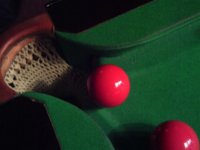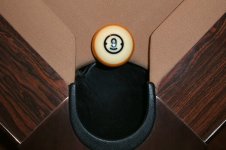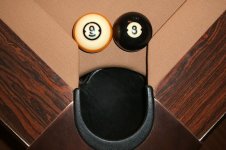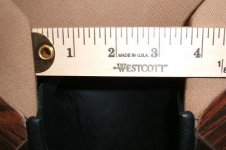Fred Agnir said:
I'll bump this to the top. While we're at it, I was in England the other day, and I happened upon two snooker tables. So, I took a photo of the pockets. For you snooker aficionados, could you also take a photo of what you deem as a normal pocket and ball, a club pocket and ball, and a professional pocket and ball?
Sincerely,
Fred <~~~ your non-angry peer
Some info I collected on Snooker Pockets:
---------
Official templates are supplied, under licence from the WSA, by E.J. Riley & Co. The variation in pockets normally comes from the drop of the slate, rather than the pocket openings. The deeper the slate is built into the pocket, the tighter a pocket effectively becomes. All tables used in WSA World Rankings tournaments have to conform to the official templates. You will often hear views expressed that "our" club tables are tighter than the TV tables, they've been templated. Maybe, but I've played on both and the only time I've come across tables that play tighter than the TV Match tables is when playing on old "Billiards" tables, where the middle pockets in particular can be excessively tight.
-------------
Templates
Templates are used to check that the shape of the pocket
openings are correct. They are made as sets of four, two
to measure the corner pockets, and two the middle.
Of each pair, one measures the width and shape of the top
of the cushion and that the pocket doesn't narrow towards
the back of the pocket. The other checks the 'fall', and the
'face' of the cushion as it curves inwards - if the 'undercut'
is cut too generously it can effectively make the pocket
opening wider.
See:- Face · Fall · Undercut
-----------------
Pockets changed, not so much in size as in shape. Initially the cushion rubbers were shaped as squarely at the entrance to the pockets as they were elsewhere but this meant that a ball could not enter a pocket unless it did not touch the sides or brushed the jaw by the merest fraction.
Easier access was promoted by the cutting away the underside of the rectangular shape of the rubber in such a way that the ball was turned towards the pocket rather than allowed to bounce off the cushion at the usual angle. The extent and angle of this cut-away of the underside of the rubber has a crucial influence on the ease of pocket entry. The greater the undrcut, the more it is possible for the the rounded surface of the ball to tuck underneath it and thus enter the pocket.
The Billiards and Snooker Control Council's (B&SCC) official templates as adopted in 1892, were of limited value in that they measured only the width of the pockets and took no account of the undercut. Thus, te templates could fit either a pocket which players found very easy or one which they found nearly impossible. The ease or difficulty therefore of championship tables thus became largely a matter of custom or preference with a general tendency towards ease of play.
After decades of petty wrangling among the trade firms, who had to produce tables to meet the requirements and rules of the governing bodies, a sub-committee of the International Billiards and Snooker Federation (IBSF) was entrusted with the design of a new template specifying the degree of undercut and ensuring that the pocket did not narrow beyond the edge of the playing surface. Pockets which had not incorporated the latter stipulation tended to reject even accurately struck balls if played at speed from narrow angles - that is positions in which the player could not aim at the full width of the pocket opening.
The new template designed by Norman Clare, was accepted by the IBSF and B & SCC in 1980.
----------
Now these are tight pockets....Russian Game








